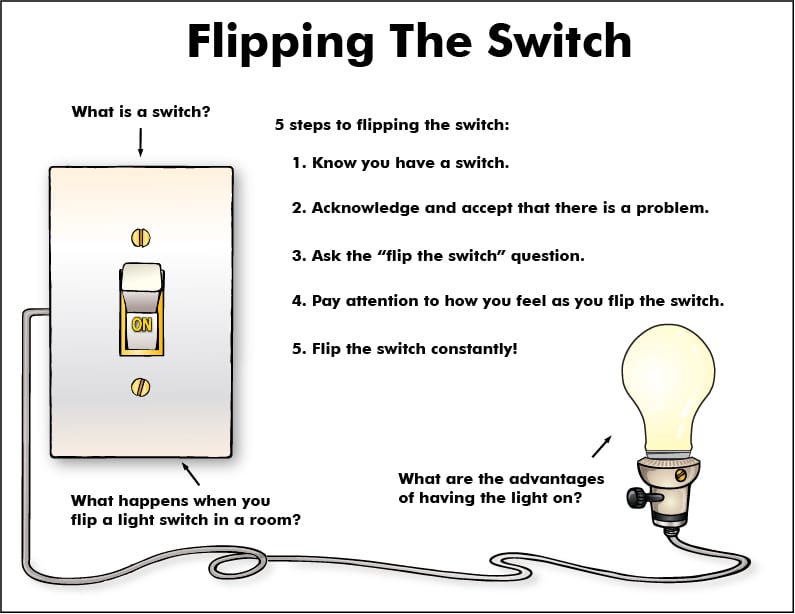Flip the Switch
What is Flipping the Switch?
Flipping the switch: When you flip the switch, you stop for a moment, realize you can turn pain into power, and move forward, committed to being resilient.

Listen to this Chapter
How Flipping the Switch Leads to Resilience
Have you ever walked into a dark room and bumped into furniture, or stepped on an unsuspecting Lego? It can be frustrating to not see what’s in front of you. But when you flip on the light switch, that all changes – you can see the obstacles in your path, find what you’re looking for, and be on your way. Imagine that there’s also a light switch inside your brain. When it’s turned on, you’re responding resiliently to life’s challenges. When it’s off, you’re not.

Flipping the switch happens in the moment of a challenge – it’s your decision right then and there to take your challenge by the horns and not shut down or give up. When you really think about it, change doesn’t have to take a long time. It’s instantaneous. It’s actually not changing that takes time. You can be resilient right now.
Flipping the switch requires taking action. But how does a parent create an atmosphere in his or her family that enables each member to bounce back and thrive in light of the setbacks they encounter. Flipping on the resilience switch allows someone facing adversity to see his or her circumstances in an entirely new light. To be even more specific, when you flip the switch, you stop for a moment, realize you can turn pain into power, and move forward committed to being resilient. We all have a switch inside of us; however, many people are unaware they even have this switch and how to go about flipping it to the “on” position. They stay stuck in the “off” position, not tapping into the resilience that’s already inside them.
The Steps to Flipping the Switch
Flipping the resilience switch is actually a skill that can be learned, but it takes knowing the steps, as well as consistent practice to create greater resilience.
The Flip the Switch Question:
How can I use this challenge or emotion to better my circumstances or create a productive outcome right now?
- Know you have a switch. You’ve got to believe in your ability to see your problem differently before you can take steps to do so.
- Combat denial and acknowledge the problem. This means we turn the light on the situation and accept it for what it is. As a case study, let’s say that you and your partner argue frequently over the family budget. Step 2 in that situation would mean acknowledging the specific problem you’re having with your spouse at that moment: that you’re not seeing eye to eye on finances and your differences of opinion are making both of you upset.
- Ask the Flip the Switch Question. When you as the spouse in this situation flip the switch, you might see the conflict as a reason to work harder to come up with a solution together. You might stop arguing your position and ask yourself what needs to be done to get the conversation into problem-solving mode.
The conversation might look less hurtful and more like you saying, “We clearly both see things differently. Why don’t you share your thoughts, I’ll listen carefully, and then I’ll share mine. Then maybe we can work out a solution we’re both happy with. What do you think?” - Notice how you feel after flipping the switch. This is the payoff. Did the respectful and solution-focused approach make for a better discussion than if you had gotten defensive and raised your voice? Do you have more energy, optimism, enthusiasm, hope, or motivation? Are you thinking more clearly? Identifying any emotional payoff can serve as motivation to flip the switch again.
Remember to flip the switch constantly. There is no circumstance where these steps don’t apply!
The Outcomes of Flipping the Switch
Outcomes of flipping the switch generally include one or more of the following:
- You give hope to others as they watch you handle your situation with strength.
- Your dignity, self-respect, and confidence increase.
- You get your power back because you’re making a decision that puts you in control.
- Inner healing occurs more quickly.
- You have something to do with the pain.
- Your anger is put in check because now you have a new perspective and can see anger as a fuel source.
- You perform real service to others because your focus is turned outward.
- You have increased empathy and compassion for others who are dealing with pain.
- You think more clearly because you have insight that pain can be converted into positive fuel.

Quick Activity: Have one or more of your children make a sign that reads, “Am I flipping the switch today?” and post it on the refrigerator.
Discussing Flipping the Switch with Your Child
Explain the Flip the Switch metaphor by walking over to the light switch and turning it on and off several times. Explain that a “flipping the switch” allows us to turn something on or off and that just like a light switch, we have a switch in our brain that helps us see hard situations in a whole new light.
When you flip the switch, you stop for a moment, realize you can turn pain into power, and move forward, committed to being resilient. We all have a switch inside of us; however, many people are unaware that they even have this switch and how to go about flipping it to the “on” position. Flipping the switch is a skill that can be learned, but it takes knowing the steps and consistent practice to create greater resilience.

Reflection
Think about a recent situation or challenge you faced in your family. What happened? Are you pleased with the result? If not, create some strategies to remind yourself to flip the switch in similar situations in the future.

Flipping the switch isn’t a one-time event; you can’t do it once and hope it stays on for your entire life. You have to be constantly flipping the switch. You might have to flip the switch ten times in one day. You might have days where you have to flip the switch every hour, or even ten seconds.”
